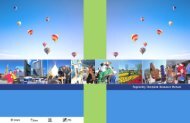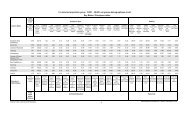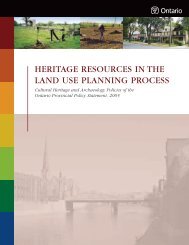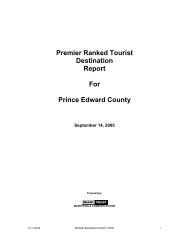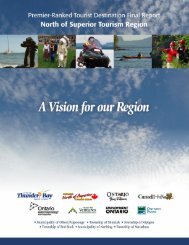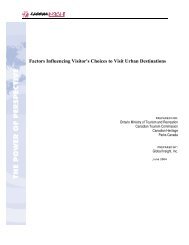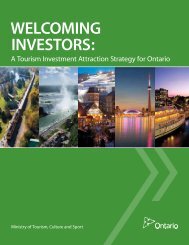Management Guidelines For Forestry and Resource-Based Tourism
Management Guidelines For Forestry and Resource-Based Tourism
Management Guidelines For Forestry and Resource-Based Tourism
- No tags were found...
Create successful ePaper yourself
Turn your PDF publications into a flip-book with our unique Google optimized e-Paper software.
<strong>Management</strong> <strong>Guidelines</strong> for <strong>For</strong>estry <strong>and</strong> <strong>Resource</strong>-<strong>Based</strong> <strong>Tourism</strong> – INTRODUCTIONcreative discussions, where both underst<strong>and</strong> eachother’s interests, are often more rewarding for bothparties <strong>and</strong> enable the flexibility required to accommodateboth interests.1.3.3 <strong>Resource</strong>-based <strong>Tourism</strong> IndustryProducts - Remote, Semi-Remote &Drive-InThe resource-based tourist industry itself can be dividedinto three broad categories: remote, semi-remote <strong>and</strong>drive-in operations. The following definitions are consistentwith <strong>and</strong> derived from Ontario’s "<strong>Resource</strong>-based<strong>Tourism</strong> Policy Information Bulletin #1 – May 1998."1. Remote <strong>Resource</strong>-based tourism - a tourismresource, opportunity, value or potential developmentthat is not accessible by road <strong>and</strong> is based on aremote wilderness experience where access is onlygained through air, water or rail. The importantattributes of this product include inaccessibility, isolationfrom visual <strong>and</strong> auditory impacts, <strong>and</strong> high qualityenvironmental resources (e.g. fish <strong>and</strong> wildlife).2. Semi-remote <strong>Resource</strong>-based tourism - similarto a remote resource-based tourism opportunityexcept that road access is limited <strong>and</strong> may be controlledthrough artificial means or the use may belimited to protect the resources, opportunity orvalue. The non-traditional means of access include:restricted road, ATV trail, marine 1 , <strong>and</strong> portage 2 .The same attributes that are important to remoteresource-based tourism are important here as well,except as how they are changed by the lesseramount of remoteness.3. Drive-in resource-based tourism - includesunencumbered road access in regards to the use ofthe resource-based tourism resource. Importantcharacteristics of this resource include full accessibility,composite use 3 , maintenance of both thevisual <strong>and</strong> auditory environmental setting 4 <strong>and</strong>access to good quality resources 5 .1 Marine refers to traditional waterway access.2 Portage refers to canoe routes3 Composite use refers to two or morecompatible uses co-existing in proximity to one another4 Refers to the protection of skyline areas of concern <strong>and</strong> man-madenoise abatement5 Refers to the importance of having access to ecologicallysustainable l<strong>and</strong>,1.3.4 <strong>For</strong>est <strong>Management</strong> Activities AffectingThe <strong>Resource</strong>-based <strong>Tourism</strong> IndustryIn section 1.3.1, values that are important to theresource-based tourism <strong>and</strong> forest industries werediscussed.Some tourism values such as those related to thesustainability of a fishery or moose population areaddressed in other forest management guidelines.Those tourism values which are more socially based<strong>and</strong> are key to the management of effects at theresource-based tourism/forestry interface are thesubject of the <strong>Management</strong> <strong>Guidelines</strong> for <strong>For</strong>estry <strong>and</strong><strong>Resource</strong>-based <strong>Tourism</strong>. Issues associated with thesevalues commonly emerge around the following areas:• Access impacts (e.g. access to previously remotelakes or rivers).• Visual impacts (e.g. harvest areas or logging roads,visible from a resource-based tourism lake orwaterbody);• Sound impacts (e.g. noise from equipment or haultrucks, heard at a remote resource-based tourismoutpost camp.)These categories are based upon predictable impacts,which have been expressed by remote resource-basedtourism industry representatives. The "remote" or"wilderness" character of an area is largely a factor ofthe relative presence or absence of visual, sound <strong>and</strong>access impacts caused by forest management operationsor some other user or use.In many cases, access related issues are the key concernof resource-based tourism industry <strong>and</strong> can be verytricky to adequately address. Critical attention must beprovided to finding solutions to access related effectsof forest management on the resource-based tourismindustry. It should also be noted that where accessrelated prescriptions fail to have the desired effect,immediate action must be taken to remedy the situation.This need to ensure that the intent or objectiveof the prescription is upheld is referred to by someas the "maintenance component" of an access relatedprescription.5



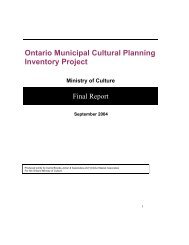
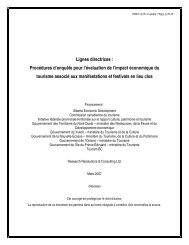
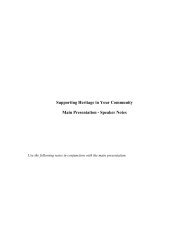
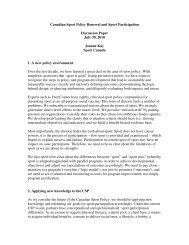
![THIS AGREEMENT made this [date], between [name of owner] (the ...](https://img.yumpu.com/49827605/1/158x260/this-agreement-made-this-date-between-name-of-owner-the-.jpg?quality=85)
